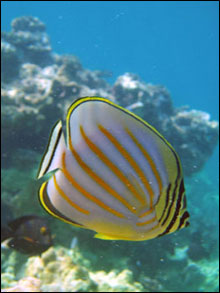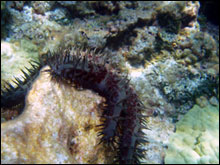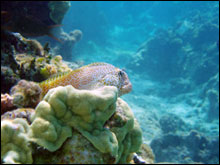|
Mission Log: July 16, 2006
Coral Predators of the
Northwestern Hawaiian Islands
Patricia Greene
NOAA Teacher-at-Sea
When you think of the Northwestern Hawaiian Islands and predators, the first thing that comes to mind may be the apex predators; tiger sharks, Galapagos sharks and species of huge fish such as the jacks.
 |
| The ornate butterflyfish (Chaetodon ornatissimus) is one type of butterflyfish that is also a coral predator. (Photo: Claire Johnson/NOAA) |
However, while snorkeling the Kure Atoll, I was reminded that there is another group of predators here; the corallivores. I observed a crown of thorns that appeared to be feeding on the coral and upon further research I discovered and recognized a variety of Northwestern Hawaiian Islands creatures that I have seen that also specialize in feeding on corals.
Corallivores (an animal that feeds on corals) may include fish, sea stars or mollusks. Generally, two types are recognized; obligate corallivores; those that feed only on corals and facultative corallivores; which feed on corals, algae, sponges, and mollusks.
 |
| The crown of thorns (Acanthaster planci) is a major predator of coral reefs. (Photo: Claire Johnson/NOAA) |
The crown of thorns (Acanthaster planci) has cryptic coloration and toxin-filled spines. It prefers to feed on rice corals (Montipora), lace corals (Pocillopora), and cauliflower corals (Acropora). Ironically, the crown of thorn eggs and larvae are often fed on by the stony corals. Other natural enemies of the crown of thorns is the harlequin shrimp and the fireworm. This little shrimp does not kill the crown of thorns, but merely creates a small, open wound. This is known as “facilitated predation.” The larvae of the fireworm then enter the cavity, reproduce, and the offspring eat the crown of thorns from the inside out; eventually causing death.
The crown of thorns feeds by inverting its stomach through its mouth, and then digests the corals externally. Human attempts at controlling populations of crown of thorns have been relatively unsuccessful and causes of these population spikes or outbreaks have been a topic of debate. Some believe they are natural occurrences and occur in cycles while other scientists believe they are due to human causes such as increased sedimentation and pollution.
We have also observed a variety of butterflyfish on the reefs; all that are also coral predators. The ornate butterflyfish (Chaetodon ornatissimus), the oval butterflyfish (Chaetodon lunulatus), the fourspot butterflyfish (Chaetodon quadrimaculatus), and the multiband butterflyfish (Chaetodon multicinctus), are all obligate corallivores. Other butterflyfish that eat both corals and invertebrates include; the threadfin butterflyfish (Chaetodon auriga) and the teardrop butterflyfish (Chaetodon unimaculatus).
 |
| The shortbodied blenny (Exallias brevis) is an obligate corallivore, which feeds on coral. (Photo: Claire Johnson/NOAA) |
The shortbodied blenny (Exallias brevis) is an obligate corallivore. It prefers the lobe (Porites lobata) and finger coral (Porites compressa). The spotted color of these fish blends nicely with the colonies of coral. Removing tiny bites these fish have little impact on the health of the corals. The coral colony is able to regenerate new polyps and fill in he bite marks.
We have also identified the spotted pufferfish (Arothron meleagris) hiding in the corals of Kure Atoll’s lagoon. This unique creature has a beak-like mouth with sharp frontal teeth for removing pieces of substrate and flat teeth in the back for grinding. They feed on a variety of organisms, including the stony corals and calcareous algae. They have a unique adaptation that allows them to lodge their bodies into a crevice or hole and then puff up so it is impossible for a predator to dislodge them. Their tissue is relatively toxic to humans.
The blue-eye damselfish (Plectroglyphidodon johnstonianus) inhabits the Northwestern Hawaiian Islands coral reefs. It feeds only on coral, preferring the lace, antler, cauliflower, finger and lobe corals. These small fish are very territorial and will defend their nests, hiding in the corals that also serve as food.
Most of the coral predators do not pose any major threats to the coral reefs. They are natural inhabitants of the reefs and do little damage. The crown of thorns can cause mass devastation; during major outbreaks at other Pacific Ocean locations the coral cover was reduced from 78% to 2%. In 1970, approximately 26,000 crown of thorns were destroyed off the southern coast of Moloka`i. However, during all of dives in the Northwestern Hawaiian Islands we only observed two crown of thorns, which is good news for this remote region.
References
Gulko, David. 1998. Hawaiian Coral Reef Ecology. Mutual Publishing.
|



